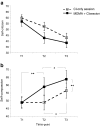Additive Effects of 3,4-Methylenedioxymethamphetamine (MDMA) and Compassionate Imagery on Self-Compassion in Recreational Users of Ecstasy
- PMID: 30100932
- PMCID: PMC6061231
- DOI: 10.1007/s12671-017-0849-0
Additive Effects of 3,4-Methylenedioxymethamphetamine (MDMA) and Compassionate Imagery on Self-Compassion in Recreational Users of Ecstasy
Abstract
3,4-Methylenedioxymethylamphetamine (MDMA;'ecstasy') produces prosocial subjective effects that may extend to affiliative feelings towards the self. Behavioural techniques can produce similar self-directed affiliation. For example, compassionate imagery (CI) and ecstasy reduce self-criticism and increase self-compassion to a similar extent, with the effects of CI enhanced in the presence of ecstasy. Here, we examine self-compassion and self-criticism in recreational users who consumed chemically verified MDMA in a within-subjects crossover study. In a naturalistic setting, polydrug-using participants performed a self-focused CI exercise on two occasions separated by ≥6 days: once having consumed self-sourced MDMA and once not. Effects on state self-criticism, self-compassion and emotional empathy were assessed before and after MDMA use (or over an extended baseline period on the occasion that MDMA was not consumed) and reassessed after CI. In participants (n = 20; 8 women) whose ecstasy contained MDMA and no other drug, CI and MDMA appeared to separately increase emotional empathy (to critical facial expressions) and self-compassion. The effects of CI and MDMA on self-compassion also appeared to be additive. Establishing the observed effects in controlled studies will be critical for determining the combined utility of these approaches in fostering adaptive self-attitudes in a therapeutic context.
Keywords: Compassion; Compassionate imagery; Empathy; MDMA; Prosocial; Self-compassion; Self-criticism.
Conflict of interest statement
Compliance with Ethical StandardsThe authors declare that they have no conflicts of interest.All procedures were performed in accordance with the ethical standards of the institutional and were in line with the Declaration of Helsinki. The study received ethical approval by the University College London Research Ethics Committee and was conducted under a UK Home Office license for controlled drugs.All the participants gave written informed consent at the start of the first session; all were made aware that they could withdraw from the study at any time without needing to give a reason.
Figures



References
-
- Ali F, Amorim IS, Chamorro-Premuzic T. Empathy deficits and trait emotional intelligence in psychopathy and Machiavellianism. Personality and Individual Differences. 2009;47:758–762. doi: 10.1016/j.paid.2009.06.016. - DOI
-
- Beck AT, Steer RA, Brown GK. Manual for the Beck Depression Inventory-II. San Antonio: Psychological Corporation; 1996.
LinkOut - more resources
Full Text Sources
Other Literature Sources
